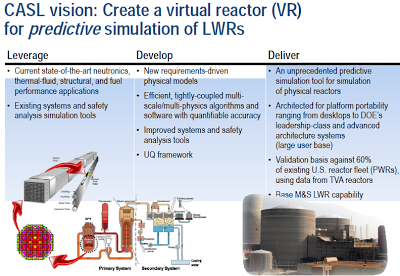1. On May 3, the Department of Energy (DOE) dedicated the Consortium for Advanced Simulation of Light Water Reactors (CASL), an advanced research facility that will accelerate the advancement of nuclear reactor technology. CASL researchers are using supercomputers to study the performance of light water reactors and to develop modeling that will help accelerate upgrades at existing U.S. nuclear plants.
These upgrades could improve the energy output of the country’s existing reactor fleet by as much as seven reactors’ worth at a fraction of the cost of building new reactors, while providing continued improvements in reliability and safety, the release from DOE said. Sophisticated models developed by CASL researchers could help accelerate upgrades at existing U.S. nuclear plants, increasing energy output and improving energy reliability and safety.
* uprates for 5–7 GWe delivered at 20% of new reactor costs
* Advances in Modeling and Simulation needed for further uprates of up to 20 GWe
* Significant financial decisions to support operation beyond 60 years are expected in 2014-2019
Less than a year after it started, CASL is already producing important research results, ORNL Director Thom Mason said. DOE announced that CASL has completed the first “virtual reactor.”
“This highly innovative software will provide improved insight into the operations of reactors, helping the industry reduce capital and operating costs, minimize nuclear waste volume, safely extend the lifetime of the current nuclear fleet and develop new materials for next-generation reactors.
Forbes – CASL will investigate ways to extend the life of existing U.S. reactors
To extend the life of reactors, the CASL team has to determine the effects of increased radiation and aging on the integrity of the reactor vessel, internal components, containment and piping.
The scientists will also investigate ways of “uprating” the power output of existing reactors, which risks damage to structures, systems, and components, fuel and steam generator integrity and may violate existing safety limits.
They will seek ways to burn more fuel more efficiently to reduce nuclear waste production, but first they have to determine whether the fuel system can handle the strain.
2. An uprate of NextEra Energy’s twin-unit Point Beach nuclear power plant in Wisconsin that will increase the generating capacity of each of the plant’s reactors by 17% has been approved by the US Nuclear Regulatory Commission (NRC). The uprate will increase the capacity of each of the pressurized water reactors from 512 MWe to 600 MWe.
If you liked this article, please give it a quick review on ycombinator or StumbleUpon. Thanks

Brian Wang is a Futurist Thought Leader and a popular Science blogger with 1 million readers per month. His blog Nextbigfuture.com is ranked #1 Science News Blog. It covers many disruptive technology and trends including Space, Robotics, Artificial Intelligence, Medicine, Anti-aging Biotechnology, and Nanotechnology.
Known for identifying cutting edge technologies, he is currently a Co-Founder of a startup and fundraiser for high potential early-stage companies. He is the Head of Research for Allocations for deep technology investments and an Angel Investor at Space Angels.
A frequent speaker at corporations, he has been a TEDx speaker, a Singularity University speaker and guest at numerous interviews for radio and podcasts. He is open to public speaking and advising engagements.






